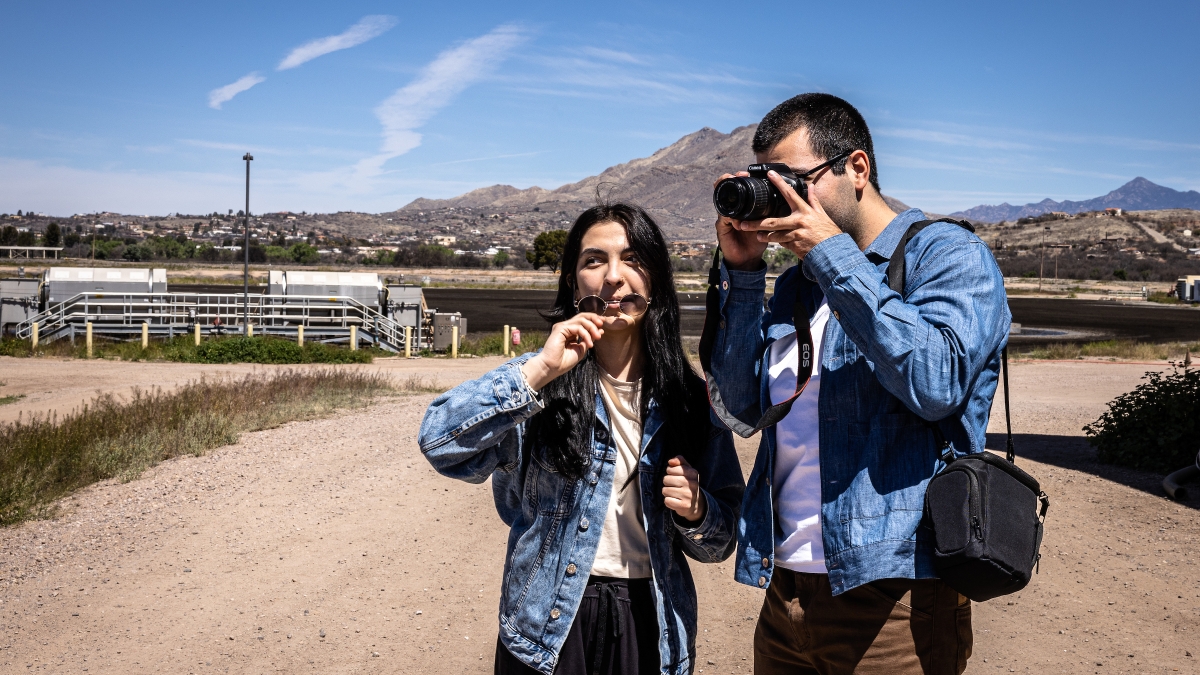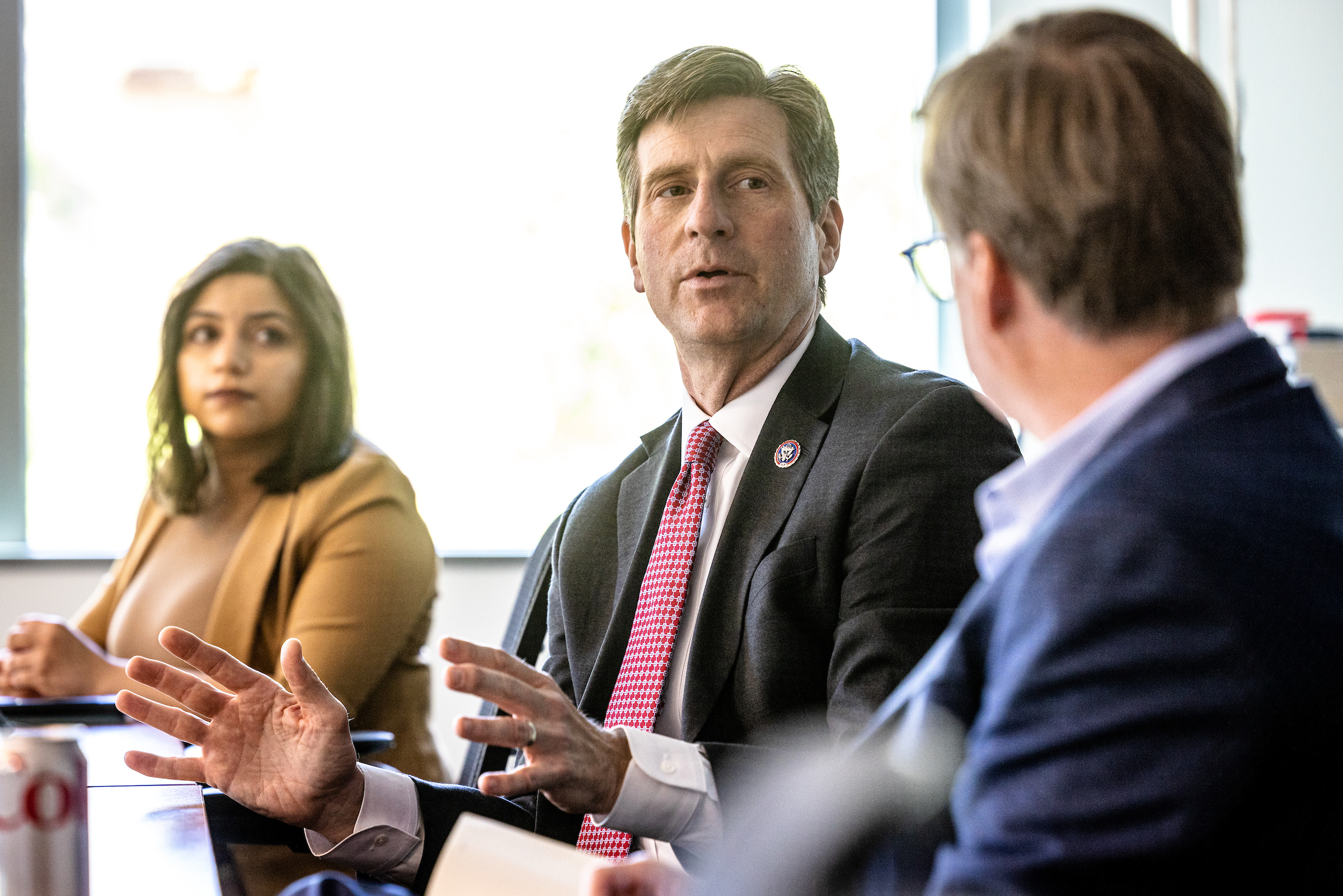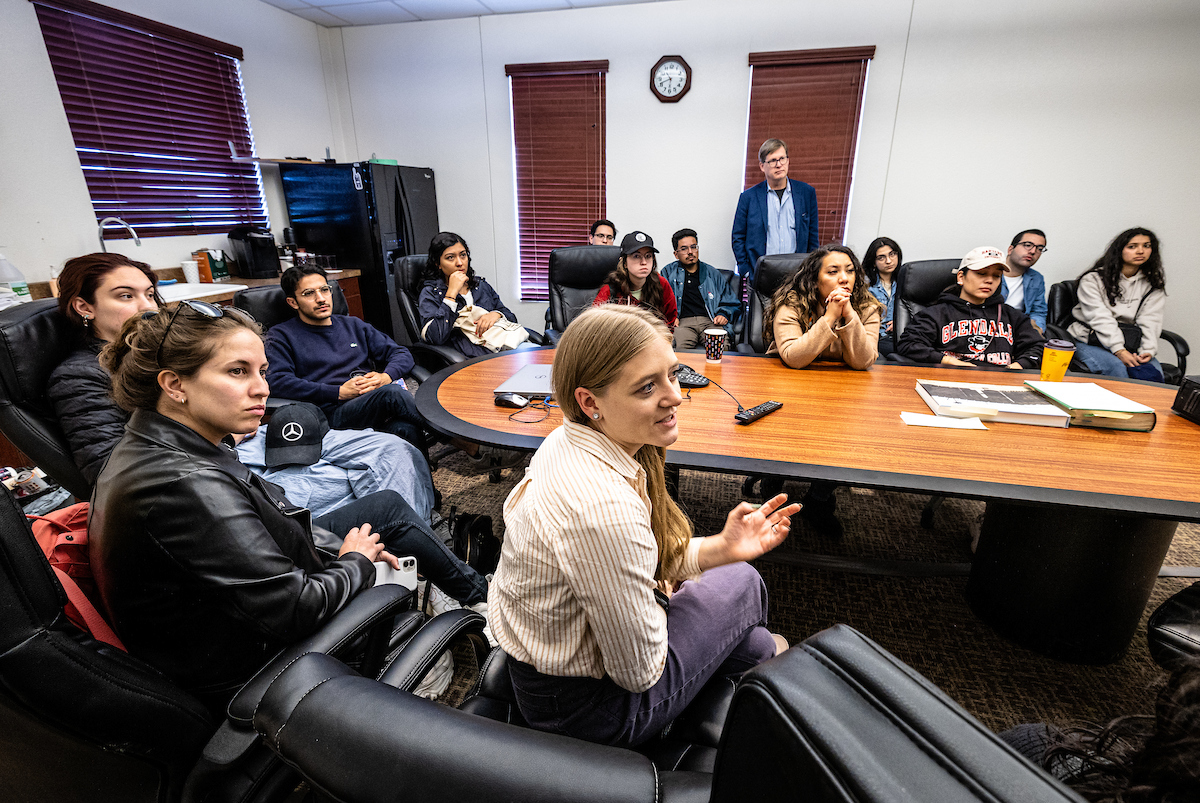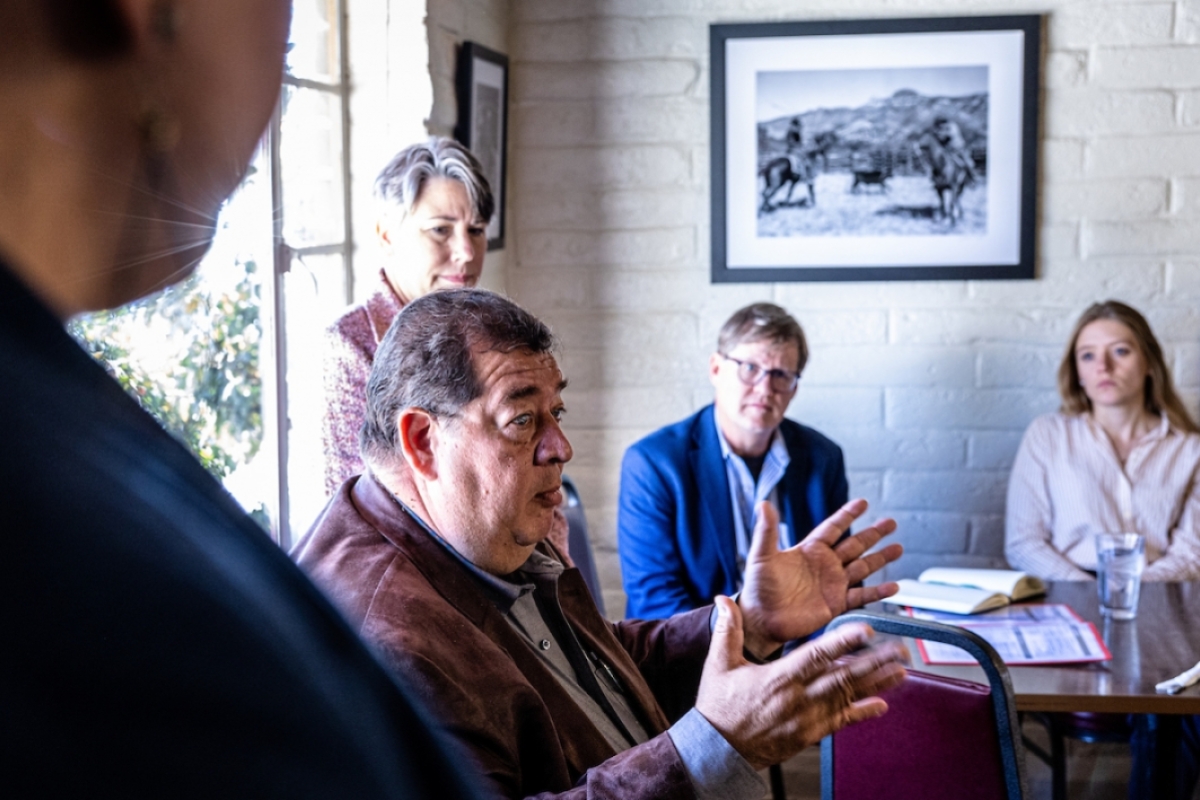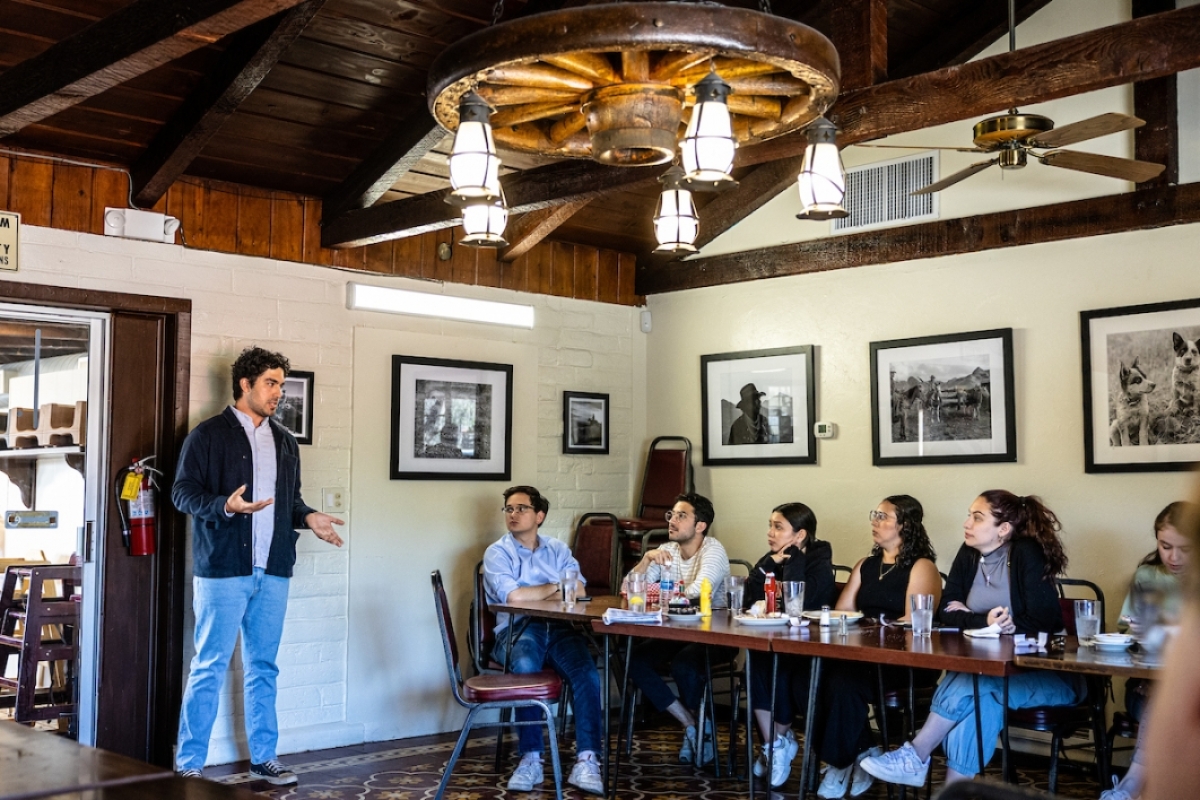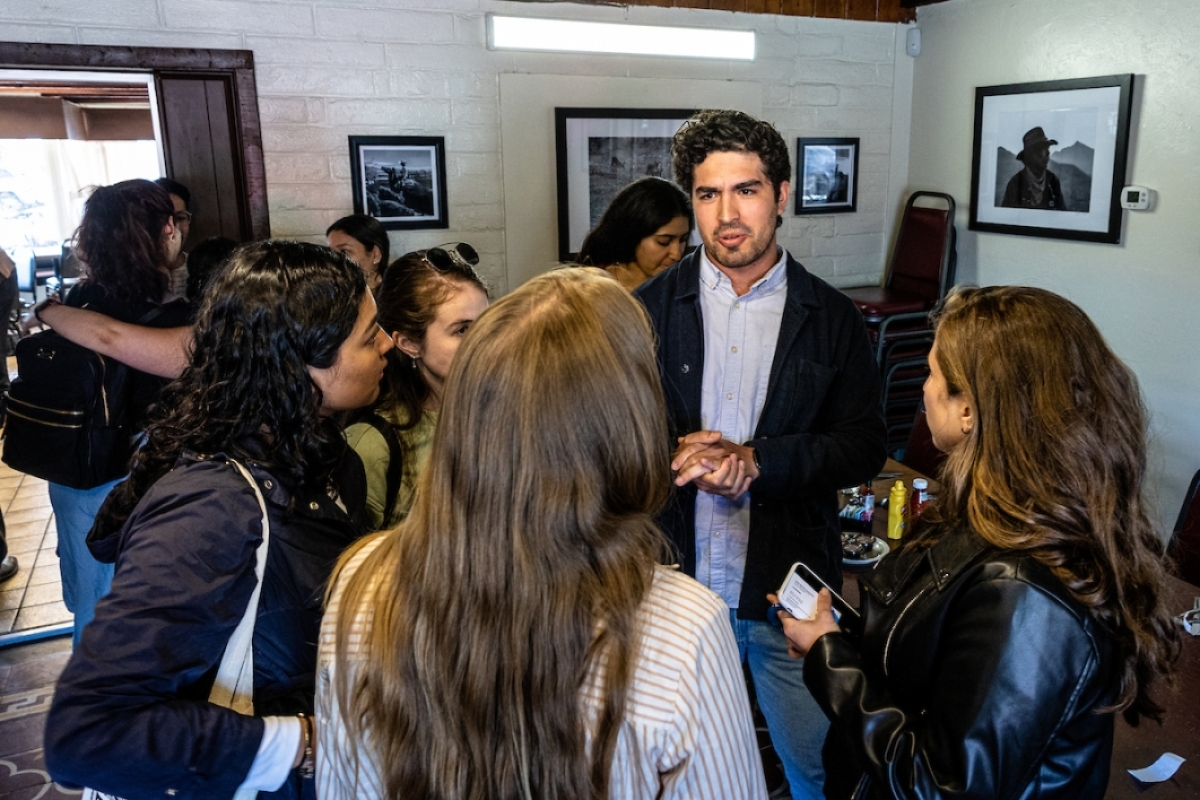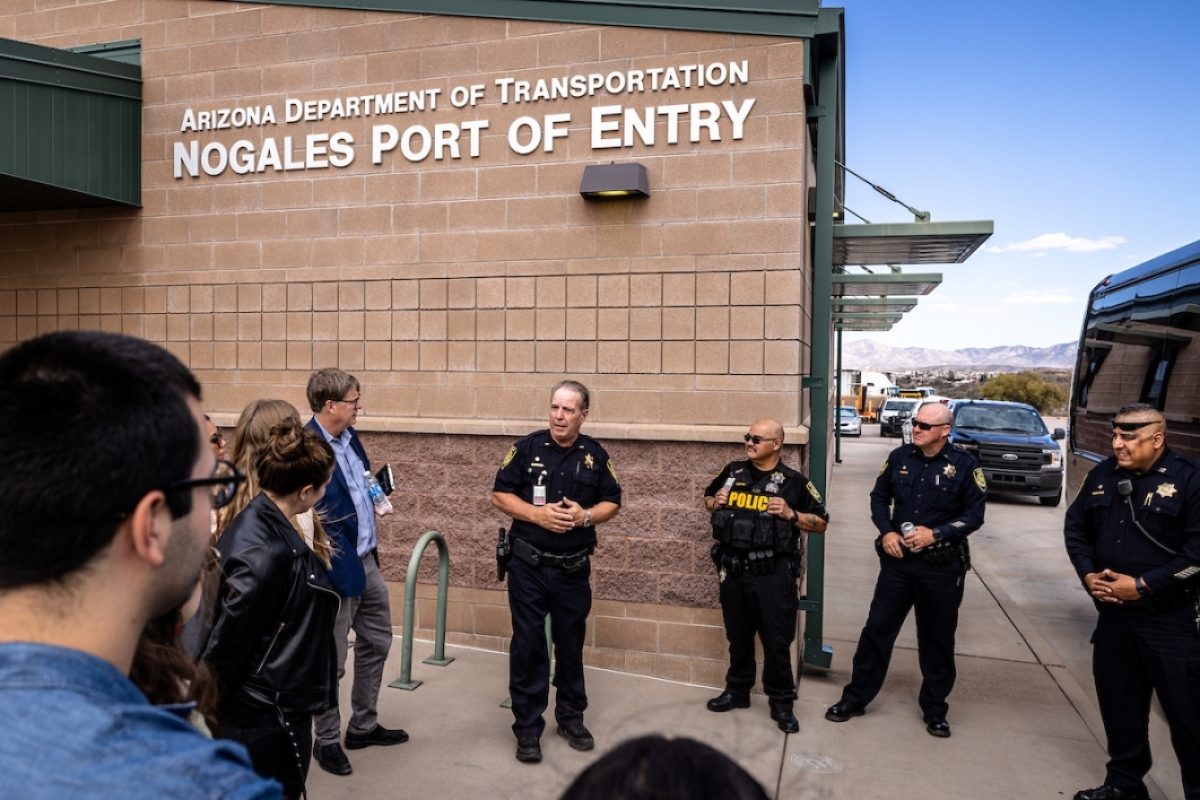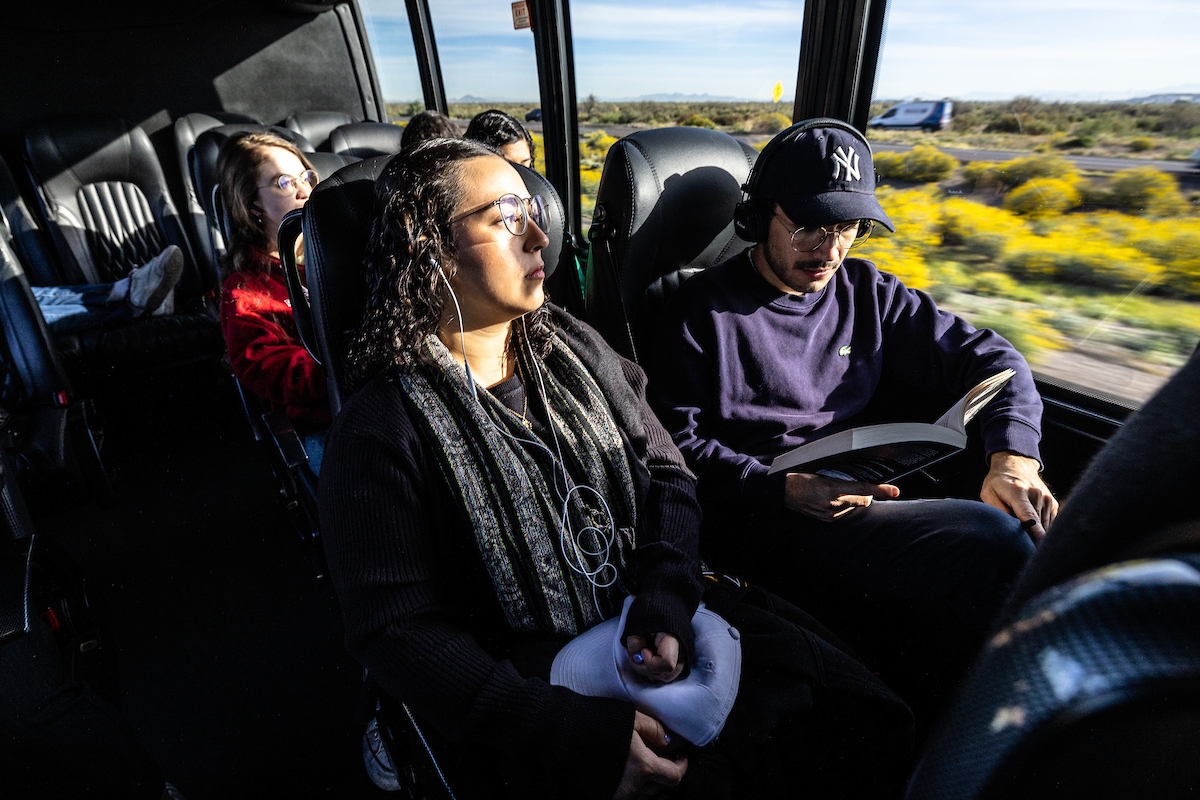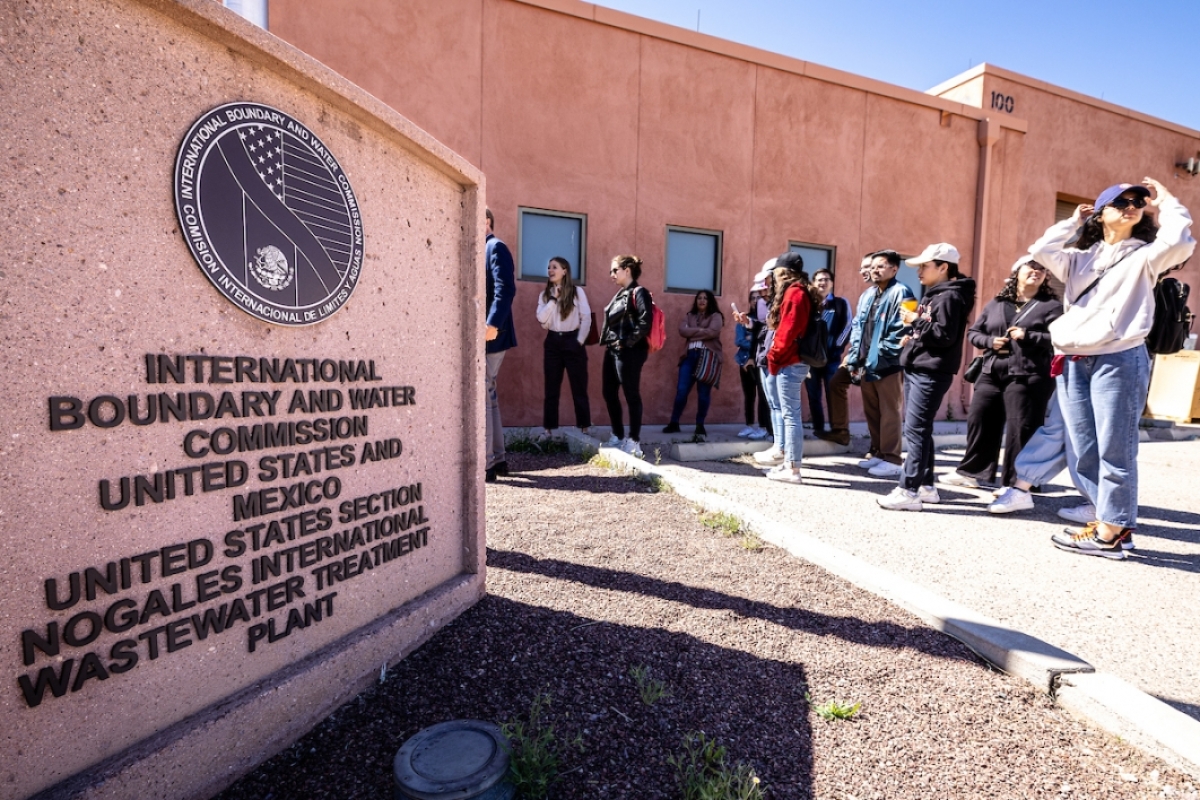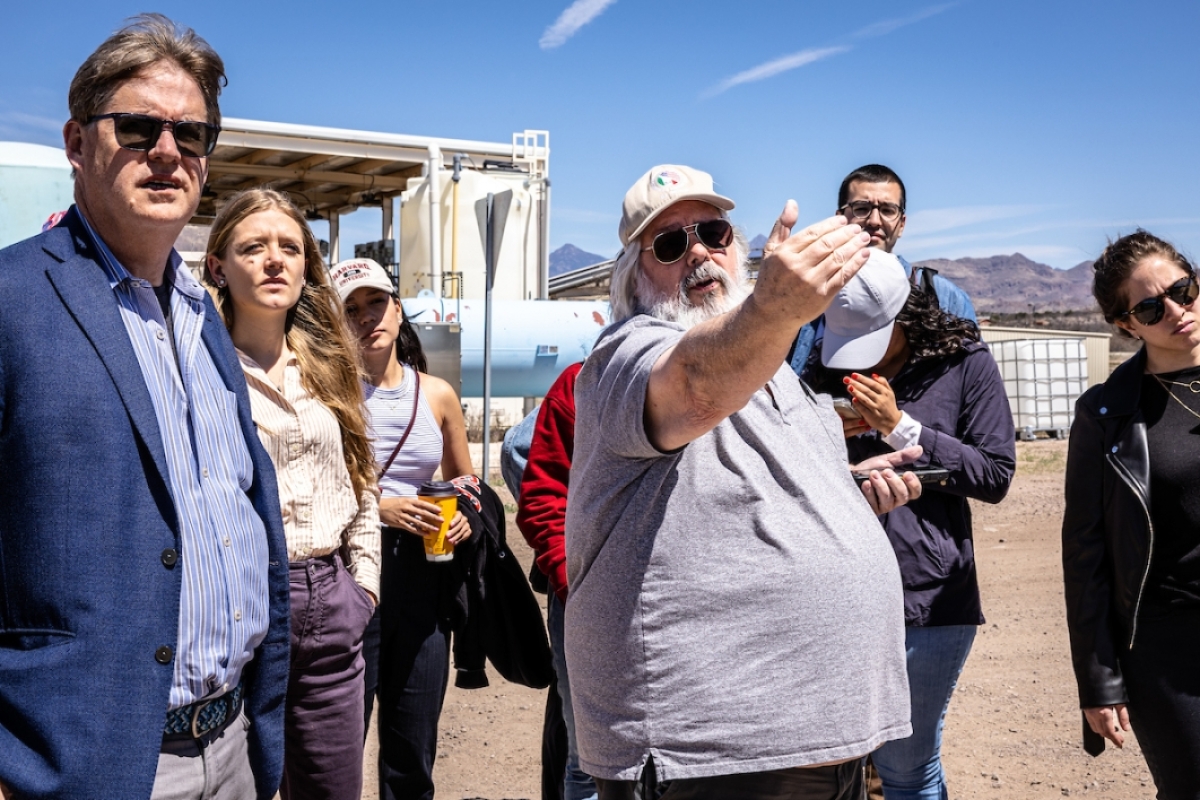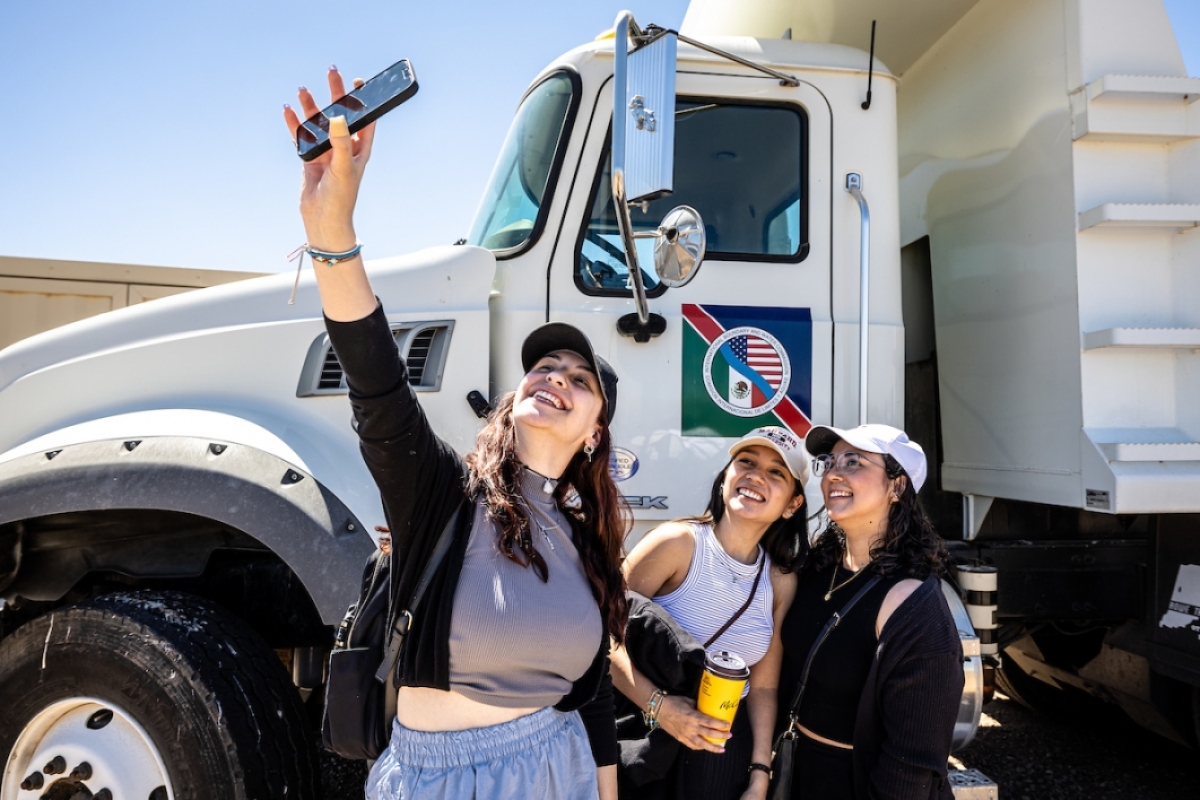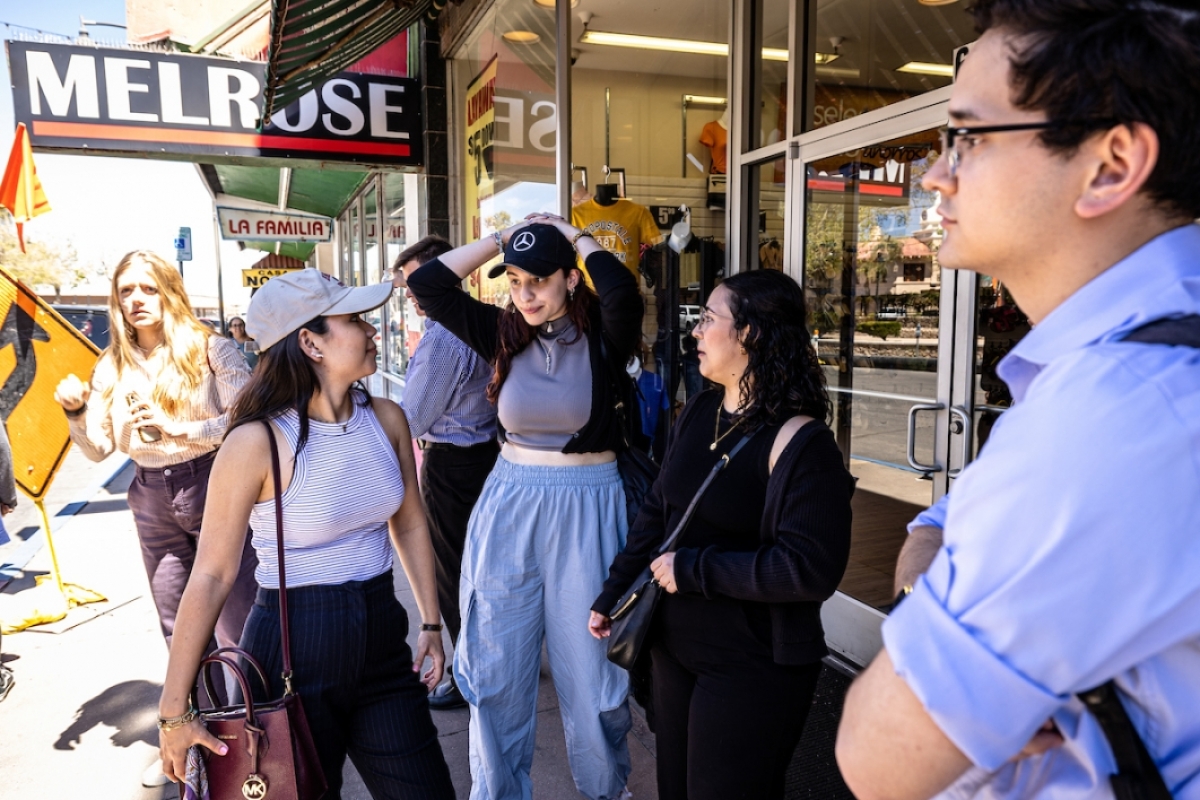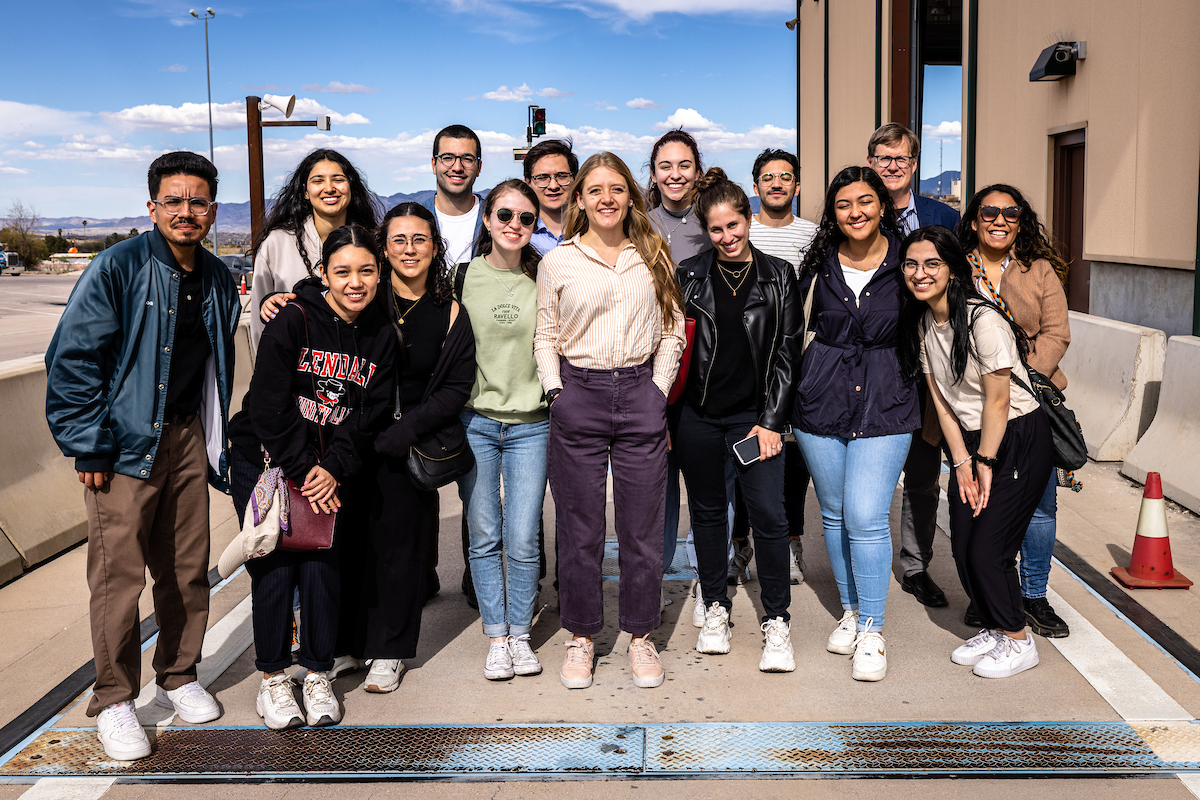With its rich blend of cultures and economies, the U.S.-Mexico border is a shared region with shared stories.
A class at Arizona State University is teaching students to find and tell those stories, along with the broader story of the relationship between the United States and Mexico.
“The gap between reality and how information is presented regarding Arizona and Mexico’s border has been distorted,” said Andrés Martinez, special advisor to ASU President Michael Crow and a professor of practice in the Walter Cronkite School of Journalism and Mass Communication. “There’s an incredibly rich, diverse relationship between our two countries and those stories need to be told.”
Martinez is touting that relationship in a class titled Advanced Bilingual Reporting, a binational collaborative online international learning course that includes students from Mexico City’s Instituto Tecnológico Autónomo de México (ITAM). The class, which is supported with a U.S. State Department grantThe core funding support is through 100,000 Strong in the Americas Innovation Fund and its partners, the Mary Jenkins Foundation along with the Coca-Cola Mexico Foundation and Sempra Energy, as part of a public-private sector collaboration between the Bureau of Western Hemisphere Affairs at the U.S. Department of State and Partners of the Americas that provide access to new models of exchange and training programs in the Americas. , is one of several offerings in Cronkite School that is part of the ASU in Mexico initiative.
The idea is to broaden the range of storytelling and develop cross-border journalism, said Mia Armstrong-López, managing editor of Symbiosis, a series of journalism-focused initiatives in Mexico.
“This class was born out of a broader desire at ASU and Cronkite to become more connected to Mexico and deepen the school’s engagement with our neighboring country,” Armstrong-López said. “A lot of students in this class will be reporting about things related to this relationship, and this experience will help contextualize the relationship for them.”
For the past semester, students worked in groups to report, write, produce and publish multimedia stories on economic development, culture, environmental sustainability, cross-border health and technology.
They also explored and compared landscapes of the U.S. and Mexican media and audiences, and how they interact with each other. Students were also able to talk to guests from such outlets as The New York Times, The Guardian, The New Yorker, NPR's "Radio Ambulante" and Mexico’s Reforma newspaper about their own reporting on the U.S.-Mexico relationship.
Alejandra Ibarra Chaoul, an investigative journalist and ITAM professor, co-taught the class with Martinez.
“I wanted to teach this class to show students they could cover both countries as an extended region with shared problems, shared interests, shared culture and shared communities,” said Ibarra Chaoul, who runs Defensores de la Democracia, a nonprofit organization that documents violence against Mexicans journalists. “It’s a great opportunity to demonstrate how to think about the two countries from a different perspective and to cover it from a different perspective.”
Ibarra Chaoul said the class is helping her students, international relations and political science majors, understand and gain knowledge regarding journalism.
“I think brings out in them their preconceived notions of journalism while at the same time expands their options when they graduate,” she said.
A new perspective
On April 3, Ibarra Chaoul and eightThe eight ITAM students who flew to Arizona are Emiliano Carvajal González, Brenda Chávez Bracamontes, Miguel Vicente Santamaría Alcaraz, Paulina Gómez Baranda Díaz, Ana Paula Juárez Alonzo, Alexa López Sánchez Mendoza, Mariana Cabello Torres and María José Ponce Gudiño. ITAM students boarded a flight bound for Phoenix to complete a cultural confluence with their Cronkite School counterparts.
Their itinerary included tours of ASU's Tempe campus and athletics facilities, the Desert Botanical Garden and the Maricopa County Superior Court. They met with U.S. Rep. Greg Stanton and held meetings with The Arizona Republic, the Consulate of Mexico in Phoenix and AlientoAn education organization serving undocumented and immigrant families. representatives to discuss the binational relationship of their individual reporting activities.
U.S. Rep. Greg Stanton (center) talks with students in the Advanced Bilingual Reporting class on April 5 in the Fulton Center on ASU's Tempe campus. Photo by Charlie Leight/ASU News
The highlight of the visit was a daylong field trip to Nogales, Arizona, to gain a firsthand understanding of the challenges and opportunities that shape the border region — and the prosperity of both countries.
The first stop was the Nogales International Wastewater Treatment Plant in Rio Rico, Arizona, where students were treated to a tour of the facility and conversation with Michael Dionne, a biological science technician with the International Boundary and Water Commission. He explained how water comes into the plant, how it’s treated and filtered, and where it ends up — and why that’s important for both countries.
“Because we have drought conditions in the Southwest, both the U.S. and Mexico face challenges of having enough water, so we have to come up with ways to treat water and benefit both sides,” Dionne said. “The key is to conserve as much water as possible so that our agriculture industry can have it to use for crops … and some of that has to go to replenish the aquifer.”
Dionne added the facility was built in 1972 and 10 plant employees treat approximately 15 million gallons a day. That information was especially helpful to Ryan Tisminezky, a Cronkite student who is reporting on water in the binational relationship.
“This tour is valuable because I am getting a little taste of what is being done right now and potentially what could be done in the future,” said Tisminezky, who expects to graduate in May with a master’s degree in mass communication. “In terms of the class, it’s like a mini-study abroad course because we’re able to immerse ourselves with people from a different country. I’m getting a new perspective.”
Mia Armstrong-López (front right), ASU in Mexico coordinator, asks questions about water issues at the Nogales International Wastewater Treatment Plant in Rio Rico, Arizona, on Thursday, April 5, 2023. Photo by Charlie Leight/ASU News
A noon luncheon doubled as an information session at Zula’s, a Mexican food restaurant in the heart of downtown Nogales. Guest speakers included Nogales Mayor Jorge Maldonado; Jaime Chamberlain, president and owner of Chamberlain Distributing Inc.; and Arizona Republic reporter José-Ignacio Castañeda.
“I’m very grateful you guys are here because you’re going to take back what you know and report on the reality of the border situation, and then go spread the word,” said Maldonado, a former city councilmember who successful ran for mayor in 2022. “For a long time, nobody was really telling our story — that we have $3 billion worth of fruits and vegetables and $26 billion in manufactured goods coming through our ports. That’s a good story to tell.”
Chamberlain said 57% of our nation’s fruits and vegetables comes through Nogales, which is vital to feeding Americans. He added that Nogales has a specific focus.
“I have visited many border towns and I have to tell you that we’re not all the same,” said Chamberlain, whose business represents 13 different farmers in Mexico and distributes their products throughout the country. “We are very different here in Nogales. We have specific economic benefits living here, which our state and federal partners have been a tremendous supporter of. When people ask me what we do, I say plainly, ‘We feed North America.’”
Castañeda, a Cronkite School graduate who reports on the border for The Arizona Republic, said his beat is interesting, diverse and rarely boring. He covers everything from commerce, crime and immigration to government agencies and the occasional ribbon cutting. He said his beat is “very personal.”
“My family’s history is tied to the border. Both of my grandparents crossed the border to work near Yuma,” Castañeda said. “I gravitate to stories about immigrants and the immigrant experience.”
The day ended with a stop at the Arizona Department of Transportation, which straddles the border. The function of this facility is to help freight move more efficiently while ensuring that commercial vehicles can operate safely on state highways, said Joseph Dopadre.
“We get about 380,000 to 390,000 trucks coming through here per year,” said Dopadre, a lieutenant with the Nogales Port of Entry. “Our job is to enforce the safety of these trucks through inspection, permitting, weight and making sure all of the paperwork is correct.”
Dopadre said his department is equipped with the latest technology – weight motion scales, facial recognition software, license plate readers, cameras, scanners and devices to keep things orderly and safe.
“We try to do the best we can do to get you in and out, but if we find out you skipped a step or have a flat tire, brake issues, or if we see a visual problem, we’ll send you back for an inspection,” Dopadre said. “Technology is helping us do our jobs safer and more efficiently.”
Lessons from the field
Being in the field can provide a different and richer experience than the classroom, and when the field is the border, layers of complexity are peeled away, according to several of the students.
“We all have our different viewpoints and I want to be a well-rounded journalist,” said Roxanne De La Rosa, who will receive her bachelor’s degree in journalism and mass communication in May. “My mom is Mexican and my dad was undocumented when he came to the U.S. I know what immigrants go through when they get to this country, so I want to be able to speak on those issues as a journalist."
De La Rosa spent the semester working on a story about a Yuma resident who crossed the border to Mexico to receive in vitro fertilization (IVF). She had three children as a result.
“She was a registered nurse, had a good job, but could not afford IVF in the States. She’s one of Mexico’s success stories,” De La Rosa said. “My story explores the inequities in the health-care system in the States and why medical tourism is becoming attractive to Americans.”
Alexa López Sánchez Mendoza is exploring a similar topic — the mental health of female immigrants who cross the border.
“There’s a lot of chaos at the border and a lot of vulnerable people coming from Central America are being taken advantage of by organized crime,” said Sánchez Mendoza, an international relations major at ITAM and editor of her school newspaper, El Supuesto. “They are dealing with the heat and the cold, coyotes, crossing the river, law enforcement and the fear of being sexually assaulted. It’s very dangerous and almost like a war experience.”
Sánchez Mendoza said her goal is to become a newspaper columnist to highlight immigrant issues in a more even-handed and humanitarian way.
“A lot of today’s (border) coverage doesn’t really tell you much,” Sánchez Mendoza said. “It’s more political coverage than anything else.”
ITAM student Paulina Gómez Baranda Diaz is also reporter for El Supuesto. She noticed an emerging trend in women’s professional soccer: Americans crossing the border to play in Mexico. She spoke to several athletes for her upcoming piece, including ASU’s Cori Sullivan, who now plays for Cruz Azul.
"(Cori) told me that she liked playing in Mexico better because the fans are amazing and the stadiums are bigger,” said Baranda Díaz, an international relations major. “It had nothing to do with money … it’s all about the fans and the energy that Mexico gives her."
Baranda Díaz said the class has pushed her in directions she didn’t always want to go but came out better for it.
“I’m not an extroverted person and I get anxious approaching total strangers,” Baranda Diaz said. “But I like how I’ve learned how to reach people and make connections. There aren’t a lot of female sports writers in Mexico, and we definitely have a different perspective about soccer than the men.”
Mexican native and Cronkite School student Paula Soria is also on a sports trek. However, her sport of choice is baseball. She’s writing about several Mexican nationals who came to the U.S. to play Major League Baseball.
“It’s a journey that usually starts at age 4 or 5, and it’s not always easy,” said Soria, who will receive her bachelor’s degree in journalism and mass communication in December. “The main challenges are usually language, culture and home sickness.”
Soria said the class has deeply impacted her writing and perspective and looks forward to writing more diverse stories.
“I came into this class thinking it was going to be about the U.S. versus Mexico,” Soria said. “But what I’ve discovered is that they are connected in a very profound way.
“They work together. They are partners.”
Students and faculty from the Advanced Bilingual Reporting class pose for a group photo at the Nogales Port of Entry on Thursday, April 5, in Nogales, Arizona. Photo by Charlie Leight/ASU News.
Other stories from the Advanced Bilingual Reporting class will cover topics including language, migration, tourism, climate change, water policy, music and tech governance. Look for them to be published on Twitter at @ASU_MX.
Top photo: Fourth-year ASU visual journalist Paula Soria helps fourth-year political relations student Emilio Carvajal, from ITAM, take a photo on Thursday, April 5, at the Nogales International Wastewater Treatment Plant in Rio Rico, Arizona. A dozen students — eight international relations students from ITAM and four journalism and mass communications students from ASU's Walter Cronkite School of Journalism and Mass Communication — spent the day on the border learning about water issues, agricultural produce and its transportation from Mexico as part of a course collaboration between the Cronkite School and ITAM. Photo by Charlie Leight/ASU News.
More Law, journalism and politics
Can elections results be counted quickly yet reliably?
Election results that are released as quickly as the public demands but are reliable enough to earn wide acceptance may not always be possible.At least that's what a bipartisan panel of elections…
Spring break trip to Hawaiʻi provides insight into Indigenous law
A group of Arizona State University law students spent a week in Hawaiʻi for spring break. And while they did take in some of the sites, sounds and tastes of the tropical destination, the trip…

LA journalists and officials gather to connect and salute fire coverage
Recognition of Los Angeles-area media coverage of the region’s January wildfires was the primary message as hundreds gathered at ASU California Center Broadway for an annual convening of journalists…


